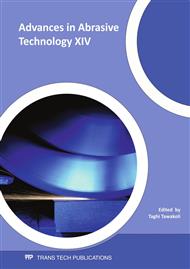[1]
Hocheng, H. and H. Y. Puw: On drilling characteristics of fiber-reinforced thermoset and thermoplastics. International Journal of Machine Tools and Manufacture, 32 (1992) 4, pp.583-592.
DOI: 10.1016/0890-6955(92)90047-k
Google Scholar
[2]
König, W., C. Wulf, P. Grass and H. Willerscheid: Machining of Fibre Reinforced Plastics. CIRP Annals - Manufacturing Technology, 34 (1985) 2, p.537–548.
DOI: 10.1016/s0007-8506(07)60186-3
Google Scholar
[3]
Chen, W. C.: Some experimental investigations in the drilling of carbon fiber-reinforced plastic (CFRP) composite laminates. International Journal of Machine Tools and Manufacture, 37 (1997) 8, p.1097–1108.
DOI: 10.1016/s0890-6955(96)00095-8
Google Scholar
[4]
Davim, J. P. und P. Reis: Drilling carbon fiber reinforced plastics manufactured by autoclave - experimental and statistical study. Materials and Design, 24 (2003) 5, p.315–324.
DOI: 10.1016/s0261-3069(03)00062-1
Google Scholar
[5]
Klocke, F. and C. Würtz: PCD in the machining of fibre-reinforced materials. Industrial Diamond Review, 59 (1999) 580, p.65–70.
Google Scholar
[6]
P.C. Upadhyay, J., S. Lyons: On the evaluation of critical thrust for delamination-free drilling of composite laminates. Journal of Reinforced Plastics and Composites 18 (1999) 14, p.1287–1303.
DOI: 10.1177/073168449901801402
Google Scholar
[7]
Krishnaraj, V., S. Pradeep and S. Vijayarangan: An Experimental and Statistical Study on the Effect of Trepanning Tool and Twist Drill on Forces and Hole Quality in Machining GFRP Composites. International Journal for Manufacturing Science Production, 7 (2006).
DOI: 10.1515/ijmsp.2006.7.1.25
Google Scholar
[8]
König, W. and P. Grass: Quality Definition and Assessment in Drilling of Fibre Reinforced Thermosets. CIRP Annals - Manufacturing Technology, 38 (1989) 1, p.119–124.
DOI: 10.1016/s0007-8506(07)62665-1
Google Scholar
[9]
König, W. and S. Rummenhöller: Spanende Bearbeitung faserverstärkter Kunststoffe. Machining of fibre reinforced plastics. Technica, 40 (1991) 10, p.75–81.
Google Scholar
[10]
Mohan, N, S. Kulkarni and A. Ramachandra: Delamination analysis in drilling process of glass fiber reinforced plastic (GFRP) composite materials. Journal of Materials Processing Technology, 186 (2007) 1–3, p.265–271.
DOI: 10.1016/j.jmatprotec.2006.12.043
Google Scholar
[11]
Faraz, A., D. Biermann und K. Weinert: Cutting edge rounding: An innovative tool wear criterion in drilling CFRP composite laminates. International Journal of Machine Tools and Manufacture, 49 (2009) 15, p.1185–1196.
DOI: 10.1016/j.ijmachtools.2009.08.002
Google Scholar
[12]
J. Sacks, W. J. Welch, T. J. Mitchell, and H. P. Wynn: Design and analysis of computer experiments, Statistical Science, 4 (1989) 4, p.409–435.
Google Scholar


